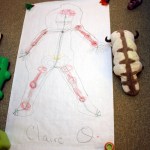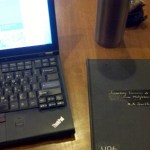
Two papers with a similar theme crossed my social media feeds in the last couple of days. You might think this is just a weird coincidence, but I'm choosing to take it as a sign to write about them for the blog.
So, what are these papers, and what's the theme? One is the final publication of some results I saw at DAMOP and alluded to back in June, and the other is from this post by Doug Natelson. Both look at the transition from few-body to many-body physics.
And this is interesting, why? I mean, isn't it obvious that you just add some more bodies? OK, I guess that does need a little more…
A couple of weeks back, DougT won this year's Nobel betting pool, and requested a post on the subject of funding of wacky ieas:
could you comment on this: http://www.space.com/22344-elon-musk-hyperloop-technology-revealed.html and the phenomenon of the uber-rich funding science in general. It seems to me that there used to be more private funding of science, and there still is a lot. But is government funding crowding out private funding (political question), is government funding necessary for Apollo and CERN b/c it’s so huge, is private funding more “out there” and therefore on the tails of…
[Scene: In the car on the way from soccer to lunch at Five Guys. SteelyKid is in her car seat, studying the Halloween-themed temporary tattoos all over her arms.]
SteelyKid: Do bats fly right-side-up, or upside-down?
Daddy: From the bat's point of view, it's right side up more or less by definition. They do sleep upside down, though.
SK: Yeah, they're the only animals that spend their time upside down. Except sometimes monkeys. Monkeys can hang upside down from their tails, and sleep that way.
D: Well, they can certainly hang upside down sometimes. Sloths spend a lot of time hanging upside…
It's that time of year again when people start thinking about Halloween costumes-- SteelyKid is apparently planning to re-use her Peter Pan outfit from last year-- and the conceptual costumes post from a while back has proved enduringly popular at this time of year. If you're not into conceptual art, though, maybe some historical cosplay is more your thing, so here are some totally serious ideas if you want to go to your local physics department's Halloween party as one of the great physicists of the last half-millennium.
Sexy Niels Bohr
This was actually the trigger for this post, when…
Via social media, John Novak cashes in a Nobel Betting Pool win from a while back, asking:
Please explain to me the relationship between energy, entropy, and free energy. Like you would explain it to a two year old child.
Why? There is a statistical algorithm called Expectation Maximization which is often explained in terms of those three quantities. But apparently entropy is hard to understand because all the detail in the analogy is heaped on entropy part (with some side tracks in Kullback-Leibler divergences.) Since I have a background in communication theory, entropy is a perfectly…
In the interest of household balance, I should note that while The Pip was home sick, SteelyKid had her first taekwondo class. She spent a week bugging us every day about wanting to go, and it falls entirely within the time of her after-school day care, so we said sure. Of course, on the actual day, she had to be basically pushed down there by her teachers, and sat most of the class out because she wasn't familiar with what they were supposed to be doing. She assures me she was watching carefully, though, and next week will do the moves with them. We'll see.
The important thing here is that…
The Pip has pinkeye. Again. This means he can't go to day care for at least one day, which means I'm home with him for the morning, and Kate will tag in at lunchtime so I can go teach my class. This, in turn, means that you don't get any substantive blogging today, because the second I start typing a real post, he'll demand... something. Hard to predict what.
Happily, this has done very little to dampen his mood-- he's fundamentally a very cheerful Little Dude, and we spent an hour or so at Panera chatting about birds and cars in the parking lot, and then ran some errands. And now, he's…
When I posted congratulating the winner of this year's Nobel betting pool, I received a gentle reminder in email that I'm a Bad Person and still haven't done one of the posts I owe to the 2011 winners. Evan reminded me that he asked for something about the delayed-choice quantum eraser, so let's talk about that a bit, in the traditional Q&A format.
So, what's a delayed choice quantum eraser do? It may or may not have rubbed out mistakes you made while writing, but you don't know until later when somebody else chooses to read it? Nothing physical gets erased. The delayed-choice quantum…
I was pleasantly surprised at how well the What does Science Online Want to Be? post was received-- I kind of expected that to cause more anger than it did. It did prompt a lot of discussion, most of it during the dinner hour in Chateau Steelypips, so it was really hard for me to keep up. Given the volume of stuff and my inability to respond promptly, I thought I'd try to round up a few things here:
1) Kelly Hills's post on cons vs. conferences is very good. This is something I said myself after Science Online this past year-- it felt very much like a SF convention. In ways both good and bad…
Having spent a bunch of time talking about heavy stuff in the science blogging community, let's unwind a bit and kick the week off with a look back at an old Master's thesis. This one is from 1932, and is almost certainly a draft copy, because it's extremely cheaply bound in cardboard with the title hand-lettered on the front. There are a few corrections in the text as well, which is very short-- just 11 pages, not counting the figures at the end.
Again, this is interesting as much for what it doesn't contain as what it does. The subject matter is pretty mundane by modern standards-- just…
The ongoing mess over Bora Zivkovic's harassment of women writers in connection with his editorial role at Scientific American and Science Online has moved into the "What is to be done now?" phase. The most prominent and linkable of these are from Maryn McKenna and Kelly Hills, though I've also seen the edges of more ephemeral discussions on Twitter. Much of this has focused on formal organizational changes, stripping Bora of power and titles and banning him from the conference. These are entirely appropriate, though partly moot given that he's resigned from both Scientific American and…
It's been a rough week, so here's some cute-kid stuff. The "featured image" above is a giant picture from SteelyKid's after-school day care, where they're talking about bodies and bones. It's a tracing of her outline, filled in with her drawings of bones, joints, a grinning skull, a brain, blood vessels, a spine, and what I think are meant to be nerves. This is all up to date with the very latest kindergarten medical science. She's even written books about it:
SteelyKid's medical books
We wanted to get a good picture of her for the jacket copy, but alas, she's too busy doing archival…
Yes, that's another TED@NYC picture as the "featured image," but don't run away! It's a post about science, I swear!
The photo up above is from the Flickr set (which, by the way, has been edited significantly since yesterday...), and I like it a good deal. Mostly because, as the joking caption suggests, that photo of Max Planck looming over my head has a kind of serial killer vibe to it. But here's the thing: this is the original phtoo that's on the slide:
Max Planck around the time he solved the black-body radiation problem. From wikimedia.
It's a black-and-white photo from 1901, and in…
There's a sense in which the saddest true statement I've read about the unpleasant events of the past week is this: Blog editor at Scientific American is a position of great power, with the ability to make or break careers.
I'm not disputing the truth of this. It's absolutely true that the position has enormous influence, and it's why Bora's actions were wrong. That is not in question. But it's sad because it's an indicator of where we've ended up, and not in a good way.
I mean, there's a limited sense, if you're a glass-half-full sort of person, in which this could be seen as a good thing.…
Let me say these things, because they are important. Bora was wrong. Scientific American was wrong. Ofek was wrong, Wrong, WRONG.
If you follow science blogs beyond this one, you have no doubt run across the gigantic debacle that erupted this past weekend; if not the first few paragraphs of this Slate piece give a reasonably compact summary. The shorter short form is: an editor at a blog network called Danielle Lee a whore (which was wrong), she wrote a blog post about it (emphatically not wrong), and the responses to that splattered a gigantic festering mess of Wrong all over everything.
So…
As noted in a previous post on Monte Carlo simulation in 1960, we recently came into possession of a large box of old Master's theses. The bulk of these are from the 50's and 60's, but there are some going back much farther. As I pass these every day I'm in the office, I thought it might be amusing to take a look at these for the blog, now and again. I don't plan to do a detailed examination of the quality of the science (at least, not necessarily), but to use this to look at how things have changed over the decades.
The first of these, pictured above, is one of the oldest: Secondary Emission…
The Twitter conversation that prompted yesterday's post about composite objects was apparently prompted by a comment somebody made about how a virus left alone would see its quantum wavefunction spread out on a time scale of minutes. This led to wondering about whether a virus could really be considered a particle that would move as a single quantum unit, and then to whether that estimate is reasonable. So, let's look at that specific question a little more closely. This is going to be one of those swashbuckling physicist estimation deals, in which I'm going to attempt to come up with numbers…
Back in July, Physics Today ran an article on Reinventing physics for life-sciences majors (I couldn't find an un-paywalled version, but this arxiv preprint seems to be close to it). As I've had some bad experiences with that class, I flagged it as something to read, but only got around to it last night. The main idea is that a "Physics for Life Sciences" course needs to be arranged around the way biologists think, which is fundamentally different than the way physicists think:
In general, physicists stress reasoning from a few fundamental principles—usually mathematically formulated—and seek…
The nice folks at TED have put up a giant Flickr set of pictures from last week's event. I'm not sure it's complete, but I happened to notice it this morning, and it already had several pictures of me in it, which is all I really care about. I particularly like the "featured image" above, which kind of makes me look like some kind of quantum demagogue urging my electrons on to more efficient production of interference patterns like the one over my shoulder.
But I also like this one, in which a deranged Max Planck looms behind me like a serial killer:
Max Planck knows what I did last summer…
I'm doing a bit of work on an idea for physics outreach, which would involve tying a discussion of modern physics to science fiction stories. I have Opinions about this sort of thing, of course, but I also have readers who might think of things I don't. So, let me throw this out to you all:
What is your favorite example of a science fiction story (here meaning print, movie, or television) making use of ideas from quantum physics? What's your least favorite?
My favorite stories invoking QM ideas are probably Robert Charles Wilson's brilliant "Divided by Infinity" (which I will draw heavily on…









